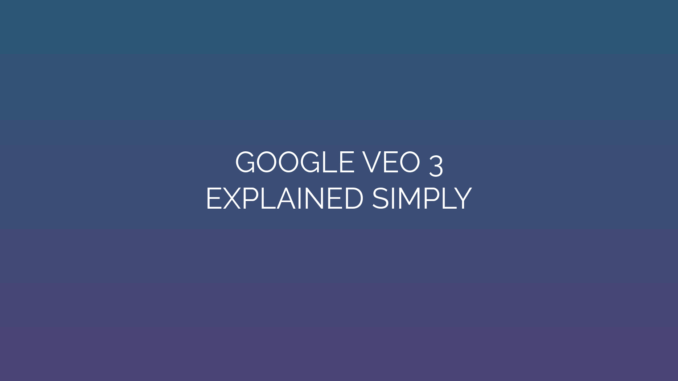
Google Veo 3 Explained Simply
The rapid evolution of artificial intelligence is reshaping creative industries, and video generation is at the forefront of this transformation. Google Veo 3 represents a significant leap in AIdriven content creation, offering filmmakers, marketers, and enthusiasts unprecedented tools to produce highquality videos from simple text prompts. This article demystifies Veo 3, its capabilities, and its potential impact—all explained in straightforward terms.
What Is Google Veo 3?
Google Veo 3 is an advanced AI video generation model developed by Google DeepMind. Building on predecessors like Imagen and earlier versions of Veo, it translates textual descriptions into realistic, highdefinition video clips. Unlike basic texttovideo tools, Veo 3 specializes in generating longer, more coherent sequences (up to 60 seconds) with cinematic quality, dynamic camera movements, and nuanced visual storytelling. Integrated into platforms like YouTube Shorts and Google’s experimental suite, it democratizes video production by automating complex editing and animation tasks.
Core Technical Innovations
Veo 3 leverages breakthroughs in diffusion models and transformer architectures. Here’s how it works:
1. Advanced Diffusion Models: Veo 3 starts with visual “noise” and iteratively refines it to match the text prompt, ensuring smooth transitions and detailed imagery. 2. Temporal Consistency Mechanisms: Unlike earlier AI video tools that produced flickering frames, Veo 3 maintains object consistency across scenes using “spatiotemporal blocks” that track elements between frames. 3. Multimodal Training: Trained on millions of videotext pairs, Veo 3 understands complex cinematic concepts like lighting, perspective, and character emotion. 4. HighResolution Output: It generates videos in 1080p resolution at 24 FPS, supporting widescreen formats for professional use.
Key Features and Capabilities
Veo 3’s functionality extends beyond basic video generation:
- Prompt-to-Video Fidelity: Understands detailed prompts (e.g., “a robot exploring a neon-lit city at dusk with a low-angle tracking shot”).
- Style and Genre Adaptability: Mimics visual styles like film noir, anime, or documentary realism.
- Edit Integration: Users can upload existing footage for AI-assisted enhancements such as background replacement or motion smoothing.
- Sound Sync: Optional audio generation synchronizes ambient sounds or music with on-screen action.
Practical Applications
- Content Creation: YouTubers rapidly prototype scenes or generate B-roll without expensive equipment.
- Advertising: Marketers create targeted video ads from product descriptions in minutes.
- Education: Teachers illustrate complex concepts (e.g., photosynthesis) through AI-generated animations.
- Storyboarding: Filmmakers visualize script sequences before live filming.
Comparison With Alternatives
Veo 3 competes with tools like OpenAI’s Sora and Runway ML, but distinguishes itself through:
| Feature | Veo 3 | Alternatives | |||| | Max Video Length | 60 seconds | Often 10–20 seconds | | Resolution | Up to 1080p | Typically 720p or lower | | Camera Control | Dynamic angles (pan, zoom) | Limited motion options | | Integration | Google ecosystem (YouTube) | Standalone platforms |
Ethical Considerations
Google implements safeguards to mitigate risks:
- Content Filters: Blocks prompts involving violence, hate speech, or copyrighted material.
- Watermarking: AI-generated videos include subtle metadata for traceability.
- Access Controls: Currently restricted to vetted creators via Google’s private beta program.
What’s Next for Veo and AI Video?
Future updates may enable:
- Real-time rendering for interactive storytelling.
- 3D environment generation for VR/AR applications.
- Personalization using user-uploaded image or style references.
As Veo 3 advances, expect debates around deepfakes, copyright, and creative labor to intensify.
Getting Started
Veo 3 is gradually rolling out to Google’s Vertex AI platform and YouTube creators. Access requires joining a waitlist at Google DeepMind’s website. Users receive credits for initial testing, with a tiered pricing model anticipated postbeta.
Conclusion
Google Veo 3 marks a paradigm shift in video creation, transforming abstract ideas into polished visual narratives with astonishing speed. While not yet flawless—occasional glitches in physics simulation remain—it dramatically lowers barriers for professionalgrade production. As this technology matures, it will empower storytellers, redefine creative workflows, and challenge our perceptions of digital artistry. For forwardthinking creators, understanding and experimenting with Veo 3 isn’t just about leveraging a tool; it’s about shaping the future of visual expression.

Leave a Reply